ASTR 1210 (O'Connell) Study Guide
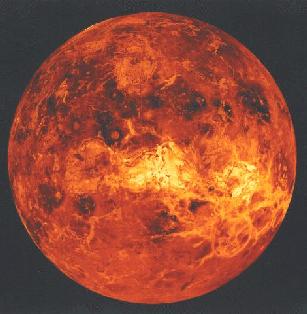 Radar map of Venus' surface, from the
Magellan Mission. The red color is artificial,
Radar map of Venus' surface, from the
Magellan Mission. The red color is artificial,intended to represent the effects of Venus' thick clouds. Click for enlargement.
A. The "Inferior" Planets
Mercury and Venus are called "inner" or "inferior" planets because they are closer to the Sun than is Earth. Both revolve around the Sun in shorter times than the Earth (88 and 225 days, respectively).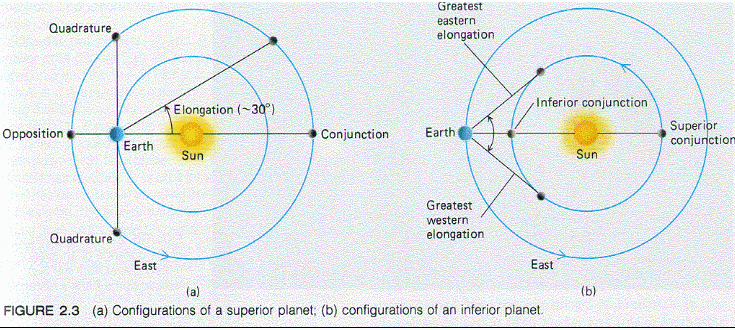
Planet-Sun Configurations
- Elongation is the angular distance of a
planet from the Sun as viewed from Earth. The
term "configurations" refers to the various characteristic
elongations possible for planets as shown in the figure above.
- As viewed from the Earth, the two planets inside the Earth's orbit can never appear at large angles from the Sun. See the illustration above. Mercury and Venus always stay within 27o and 48o, respectively, of the Sun. These are their "greatest elongations."
- Consequently, Venus and Mercury are visible in the sky only near sunset or sunrise. Venus is the most common evening or morning "star."
- An immediate implication of Copernicus' heliocentric model was that the sizes of the orbits of Mercury and Venus (relative to Earth's orbit) could be deduced from their greatest elongations. In the Ptolemaic model, there was no simple geometric method for determining the sizes of the planetary orbits.
- Because Venus' orbital period is similar to Earth's, it tends to linger in the sky near the horizon for many weeks at a time. [Recall the planetarium simulations shown during our discussion of the Maya obsession with Venus.]
- Because of its proximity to Earth and the high albedo (~70%)
produced by its thick cloud layers, Venus is the brightest object in
the sky other than the Sun or the Moon. Its
intense brightness
and white color make it look artificial.
- ===> Venus is the classic "Unidentified Flying Object" (UFO). See Guide 18 for more discussion.
- The planets outside Earth's orbit ("superior" planets),
starting with Mars, can be seen at up to 180o from the
Sun. At that point they are highest in the sky at midnight and are
said to be at "opposition" with respect to the Sun.
- As the figure shows, when a planet is at opposition, it is also nearest the Earth and therefore brightest. It will also be undergoing its fastest "retrograde motion" at that point.
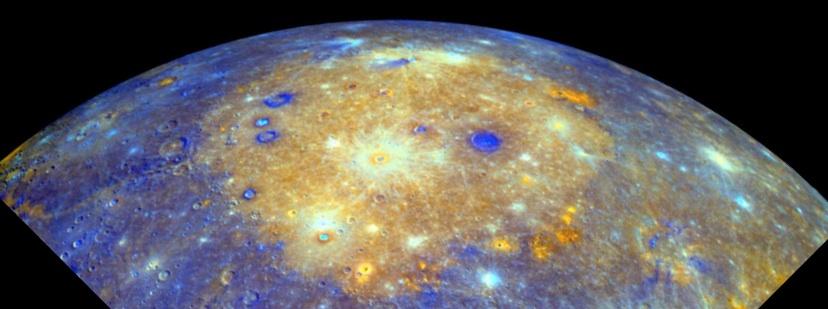
Image of the Caloris Basin on Mercury taken by the
MESSENGER spacecraft.
Color coding is for different mineral types.
B. Mercury
Mercury is hard to observe from Earth because it is above the nighttime horizon only for brief periods.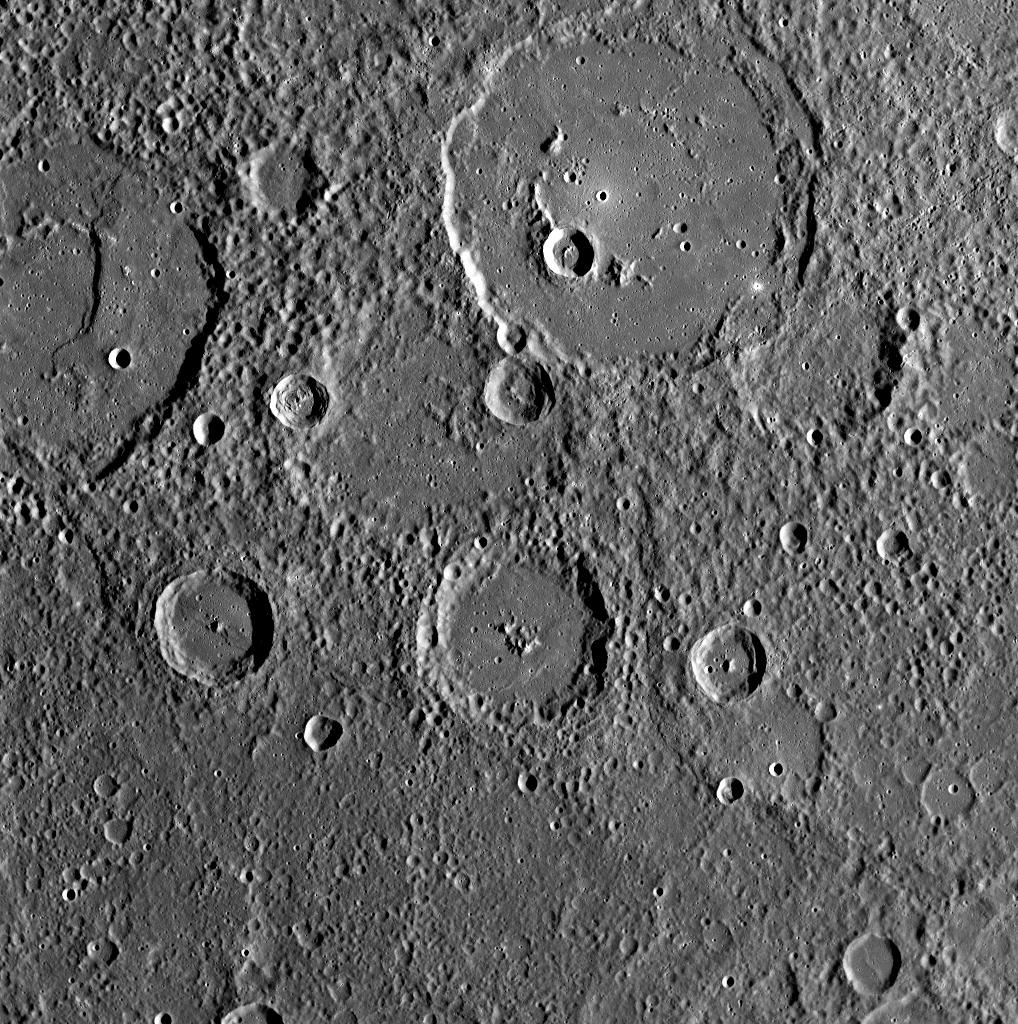 It has been less well studied than most other planets. Until 2007
there had been only 2 spacecraft visits, both flybys, in
contrast to Venus, which has been a major destination of space
missions.
Here is hemispheric
view of Mercury from Mariner 10 (1974).
It has been less well studied than most other planets. Until 2007
there had been only 2 spacecraft visits, both flybys, in
contrast to Venus, which has been a major destination of space
missions.
Here is hemispheric
view of Mercury from Mariner 10 (1974).
-
MESSENGER was an
elaborate mission (ending in 2015) to study Mercury at close range in
3 flybys followed by
long-term in-orbit observations.
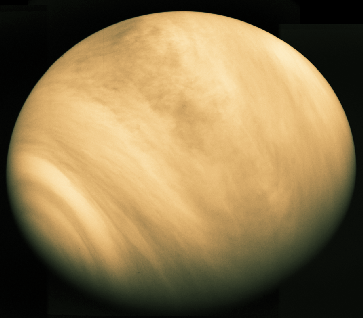 Venusian cloud layers in UV/optical bands (image from Mariner 10, 1974)
Venusian cloud layers in UV/optical bands (image from Mariner 10, 1974)
C. Venus: Introduction
Venus is a near "twin" of Earth in global properties: diameter (95%); mass (82%); distance from Sun (0.7 AU) But unlike Earth, thick cloud layers completely obscure its surface. See image above (click for enlargement).- The surface of Venus cannot be studied from outside its atmosphere at optical wavelengths.
- Clouds in planetary atmospheres are composed of liquid droplets or
ice crystals and are distinct from the atmosphere (gas) in which they
are embedded
- Therefore, it is difficult to determine cloud composition by spectroscopy (easy only for vapors).
- The naive presumption until the 1960's, given Venus' appearance and overall similarity to the Earth, was that the clouds were made of water and that the planet probably hosted a flourishing, wet, jungle-like biosphere.
-
Radio and infrared measurements from early flyby and lander
missions (1962-72) showed that Venus' surface temperature was almost
500o C (900o F) and the lower atmosphere
was crushingly dense.
Landers returned images of a bleak, lava-covered surface:
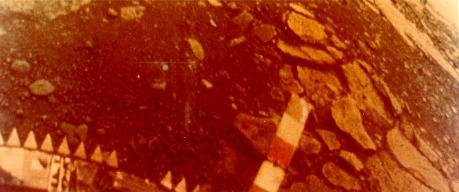 Above is a wide angle color image of Venus' surface
returned by the USSR Venera 13 lander (1982).
Above is a wide angle color image of Venus' surface
returned by the USSR Venera 13 lander (1982).It shows a lava-strewn plain, extending to the horizon at right. The reddish color is produced
by the thick cloud layer, which absorbs blue light. The lander lasted only two hours
in the heat and pressure of Venus' surface. Click for enlargement.
D. Venus: Surface/Topography
For Venus, the only feasible surface mapping technique was to use radar to penetrate the thick clouds.-
Radar systems emit a short burst of radio waves
and then detect the reflected burst to determine a target's distance
and (through the Doppler effect) motion.
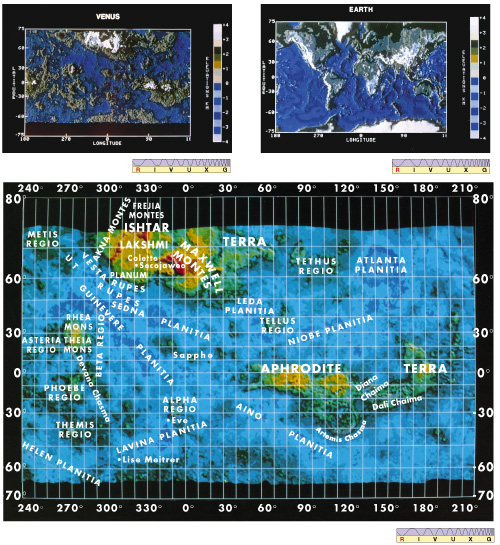
Bottom: Radar map of Venus with main features labeled. (Pioneer Mission, 1981)
-
Continents and domelike features are evidence of modest
tectonic activity, but this is much less conspicuous than
on Earth, as can be seen in the comparison images above. There are no
large-scale plates.
Given the surface temperature, there are obviously no oceans on Venus.
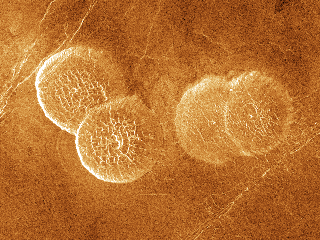 This radar image shows four overlapping volcanic domes.
They average about 16 miles in diameter
This radar image shows four overlapping volcanic domes.
They average about 16 miles in diameterwith maximum heights of 2,500 feet. They were produced by eruptions of thick lava coming from vents
on the relatively level ground, allowing the lava to flow in an even lateral pattern.
Click for enlargement.
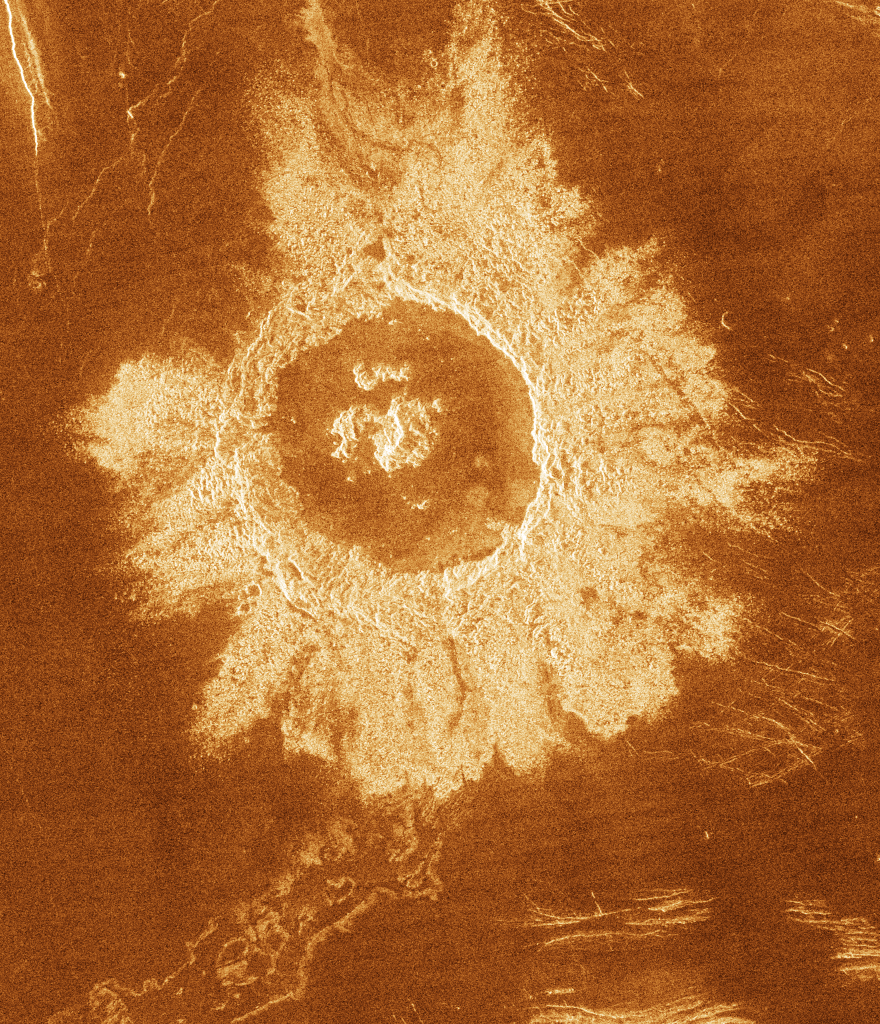 There are also many impact craters, but fewer per unit area
than on the Moon or Mercury. This implies a younger surface
than those planets.
There are also many impact craters, but fewer per unit area
than on the Moon or Mercury. This implies a younger surface
than those planets.
- Shown at right is a radar image of a 30-mile diameter impact crater surrounded by a bright "splash blanket" of ejecta. Lighter-toned regions on radar images are rougher; darker-toned are smoother. Click for a larger view.
-
This situation is unique in the Solar System (see discussions
of the Moon and the outer satellites in
other Guides).
It implies the whole surface formed at one time. Judged by the
density of impact craters, the surface is relatively young---only
about 500 Myr old, unlike the 4+ Byr-old surfaces of the
Moon, some outer satellites, etc.
The combined evidence indicates that the entire planet underwent
sudden catastrophic melting & resurfacing about 500 Myr years
ago. This event was possibly induced by a thick lithosphere which
trapped heat generated in the interior until it built up to a critical
level. This process could be
cyclic, repeating after sufficient interior heat builds up.
- Venus' surface history will be discussed in the video "Venus Unveiled."
E. Venus: Atmosphere
Venus' atmosphere is dense, hot, dry, and corrosive. At surface levels, it is entirely hostile to Earth-like life.- The bulk of the atmosphere is carbon dioxide (CO2)
- Water is almost absent on Venus. H2O vapor has only
1/10000 of its abundance on Earth, and there is no liquid water on the
surface. A dessicated planet/atmosphere.
- We will find later (Study Guide 19) that the absence of water is a key to the bizarre properties of the Venusian atmosphere.
- Lack of liquid water, which on Earth is a lubricant for the outer layers of the interior, may also act to inhibit tectonic activity on Venus.
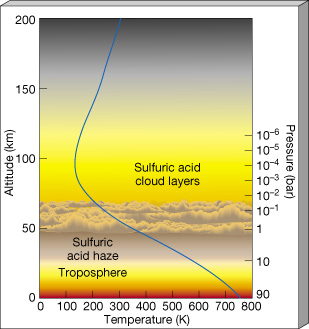
- The Venusian cloud decks? The clouds are sulfuric acid(!) droplets
- They originate from volcanic outgassing in the absence of rainfall to clean out sulfur compounds.
- There are other remarkable differences from Earth's atmosphere
- See the atmospheric profile chart above right
- Temperatures and pressures like those at Earth's surface occur at an altitude of 50 km in Venus atmosphere. Below that, pressures and temperatures are much higher than on Earth.
- The surface temperature is ~ 750oK (480oC or 900oF)!
- Venus' surface is hotter than Mercury's, despite its larger distance from the Sun!
- The surface pressure is 90x higher than on Earth. Since gravity at Venus' surface is almost the same as on the Earth, this implies Venus' atmosphere is 90 times more massive than Earth's!
- In September 2020, astronomers announced a possible detection of phosphine gas (PH3) in Venus' atmosphere, which could be an indicator of biological activity at high levels where the temperature is moderate. See Guide 23 for the latest views on this controversial result.
The Greenhouse Effect
Venus would be warmer than the Earth simply because it is nearer the Sun. But the extraordinarily high Venusian temperature is not caused only by higher solar input. Instead, it is produced by the Greenhouse Effect, an atmospheric process which inhibits surface cooling.- The surface temperature is determined by the equilibrium point, where the heating rate balances the cooling rate. If the cooling rate (i.e. the escape of radiation to space) falls below the heating rate, the temperature increases until the two match.
- The main heat input to any planetary atmosphere (including
Earth's) is from the Sun. This occurs mainly at visible
wavelengths, where the Sun is brightest.
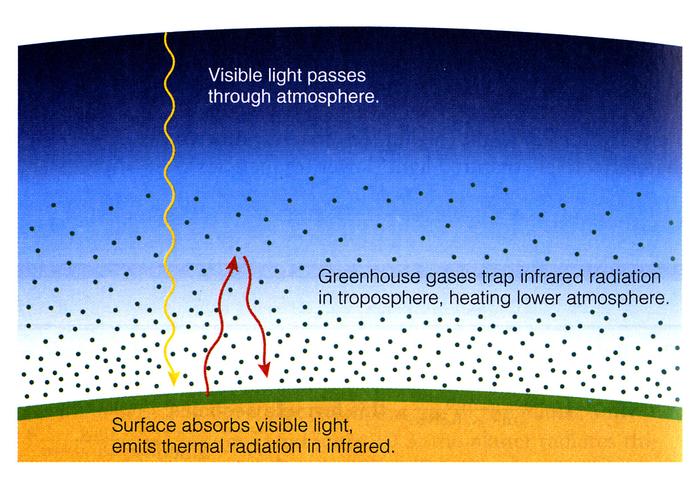
- Cooling from the surface is by
(electromagnetic) radiation to space. Because the temperature
of planetary surfaces is (fortunately for us!) much lower than the
Sun's, this occurs not at visible but instead at longer (and
invisible) infrared wavelengths.
- (See Supplements
II and III to remind yourself of the characteristics of EM radiation
from dense objects like planets.)
- Because all of the surface cooling must take place in the infrared, any gas that can impede IR radiation acts to increase the surface temperature. We call these "Greenhouse gases".
- The most important Greenhouse agents are H2O, CO2, CH4, and O3. Although these gases are transparent at optical wavelengths, they are opaque over large parts of the IR spectrum. They preferentially absorb infrared radiation and reflect it back to the planetary surface, thereby reducing radiative cooling. They act like a blanket to "trap the heat." See the sketch above right (click for enlargement).
- This causes a significant temperature rise to the point where the
surface can radiate as much energy to space (despite the Greenhouse
blocking) as it receives from the Sun. The situation is like the level
of a lake adjusting to the increased height of its outlet dam.
-
[Everyone has experienced a version of the Greenhouse Effect
themselves. When you get in a car on a sunny but cold day, the
interior is much warmer than the outer air despite the fact that the
same amount of sunlight per unit of area is falling on the nearby
ground as on the car. The air inside the car cannot cool as well as
the surrounding pavement, so it becomes much warmer than the outer
air.]
- Even tiny amounts of Greenhouse gases
can have a big effect because they choke the cooling channel.
-
Here
is a chart that shows the radiative input, output, and Greenhouse gas
blocking as a function of wavelength for the Earth's atmosphere.
- On Earth, where the Greenhouse gases are only "trace" constituents of the atmosphere (e.g. CO2 totals only 0.04% of the atmosphere's mass), the long-term Greenhouse temperature increase was a modest 30o C (or 54o F), which is just enough to keep Earth's surface "comfortable" by human standards and prevent the oceans from freezing over.
- But on Venus, where the atmosphere is almost pure CO2 and massive enough to block large regions of the infrared spectrum, the temperature rise is 400o C.
- The existence of a Greenhouse Effect for Earth's atmosphere was first recognized two centuries ago, in the 1820's. The first quantitative discussion was published in 1896 by the Swedish physicist Arrhenius, who predicted that human industrial activity might be able to produce enough CO2 to increase the temperature of Earth's surface. Evidence of human-induced increases in both atmospheric CO2 and temperature would not be clear for another 90 years (see Guide 19).
F. Venus and Earth
Venus is a sobering lesson in comparative planetology. The incredible differences between terrestrial and Venusian conditions were a great shock to astronomers. How can the atmospheres of Venus and Earth, despite their similarities in size and mass be so different? The culprit is probably the seemingly small difference in distance to the Sun (30%), as we will see in Guide 19.-
Venus is unsuitable for a biosphere for two entirely different
reasons: its hostile atmosphere and its episodes of catastrophic
resurfacing (both related to heat-trapping).
It is ironic that this horrific world was named in many cultures for
the Goddess of Love. The Maya, who believed it was a vicious god bent
on destruction, were closer to the truth.
But Venus provided another astronomical touchstone for human societies. It was
the recognition of the power of the Greenhouse Effect on Venus that
first led atmospheric scientists to become concerned about
global warming on Earth.
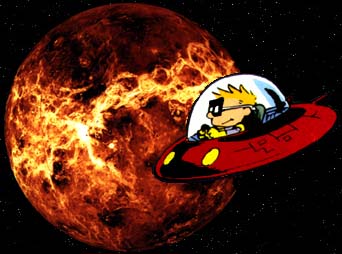 Spaceman Spiff zooms past Venus on his way to Mars --- next
lecture.
Spaceman Spiff zooms past Venus on his way to Mars --- next
lecture.
Reading for this lecture:
-
Bennett textbook: pp. 203-204; Secs. 9.3, 9.5.
Study Guide 15
Viewing: video shown in class: "NOVA: Venus Unveiled"
- If you missed the class, the video can be viewed
in Clemons Library. Its call number is VHS 13769.
-
Bennett textbook: p. 206; Sec. 9.4.
Study Guide 16
-
Mercury
Info at Views of the Solar System
Mercury MESSENGER Mission Venus Info at Views of the Solar System (includes many images, animations, links)
The Venus Magellan Mission
Animation of Venus rotation and orbital motion Interactive Simulation of the Greenhouse Effect (PhET, U. Colorado)
 Previous Guide
Previous Guide
|
 Guide Index
Guide Index
|
 Next Guide
Next Guide
|